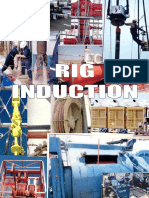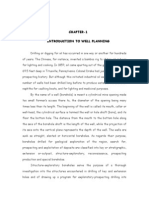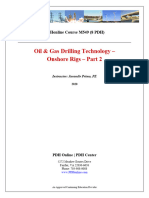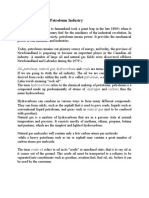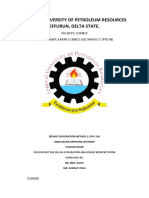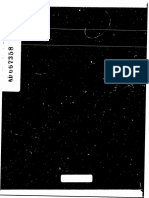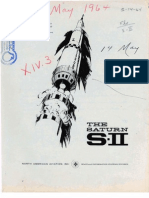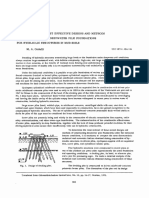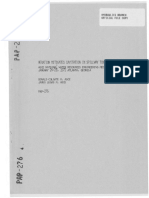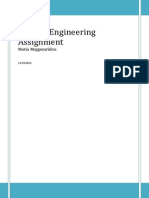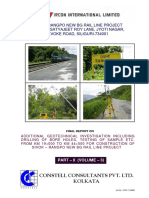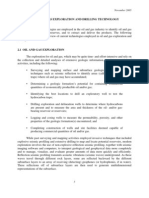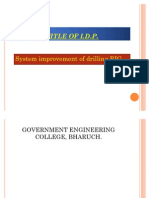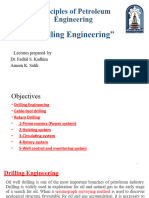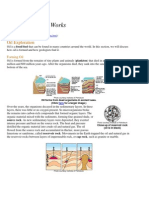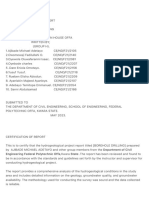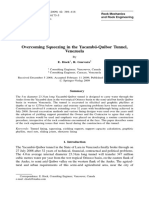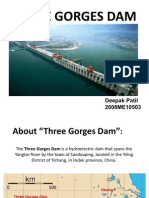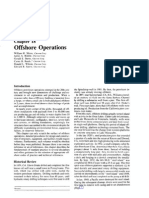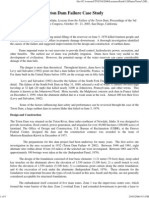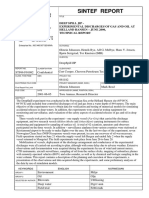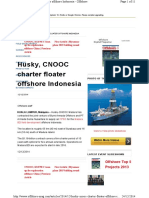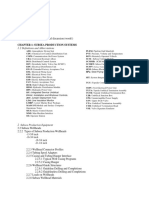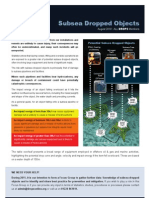Unesco - Eolss Sample Chapters: Offshore Drilling and Production Equipment
Unesco - Eolss Sample Chapters: Offshore Drilling and Production Equipment
Uploaded by
Omeruo EmekaCopyright:
Available Formats
Unesco - Eolss Sample Chapters: Offshore Drilling and Production Equipment
Unesco - Eolss Sample Chapters: Offshore Drilling and Production Equipment
Uploaded by
Omeruo EmekaOriginal Title
Copyright
Available Formats
Share this document
Did you find this document useful?
Is this content inappropriate?
Copyright:
Available Formats
Unesco - Eolss Sample Chapters: Offshore Drilling and Production Equipment
Unesco - Eolss Sample Chapters: Offshore Drilling and Production Equipment
Uploaded by
Omeruo EmekaCopyright:
Available Formats
CIVIL ENGINEERING – Vol. II - Offshore Drilling and Production Equipment - S. Tanaka, Y. Okada, Y.
Ichikawa
OFFSHORE DRILLING AND PRODUCTION EQUIPMENT
S. Tanaka
Professor Emeritus, The University of Tokyo, Tokyo, Japan
Y. Okada
General Manager, Japan Oil Engineering Co., Ltd., Tokyo, Japan
Y. Ichikawa
General Manager, Japan Drilling Co., Ltd., Tokyo, Japan
Keywords: Offshore, rotary drilling, offshore drilling rig, jack-up, semisubmersible,
drillship, offshore oil and gas production, platform, FPSO, subsea production systems
TE SS
Contents
S
1. Introduction
R
AP L
2. Outline of Rotary Drilling Method
H O
3. Offshore Drilling Structures
3.1. Technical Features of Offshore Drilling
C E
3.2. Mobile Bottom-supported Rigs
3.2.1. Jack-up Drilling Rigs (Jack-up Rigs, Self-elevating Drilling Rigs)
3.2.2. Submersible Drilling Rigs (Submersible Rigs, Swamp Barges)
E O–
3.2.3. Tender-Assisted Platforms and Tenders
3.3. Floating Offshore Drilling Rigs (Floaters)
3.3.1. Technologies Required by Floaters
3.3.2. Drillships
PL C
3.3.3. Semisubmersible Drilling Rig
M ES
3.4. Location Surveys for Offshore Drilling
4. Offshore Oil/Gas Production Systems
4.1. Brief History of Offshore Production Systems
4.2. Various Types of Offshore Platforms
SA N
4.2.1. Bottom-supported Platforms
U
4.2.2. Floating Platforms
4.3. Subsea Production Systems
4.3.1. Subsea Christmas Trees
4.3.2. Subsea Manifolds
4.3.3. Subsea Boosting and Processing
4.3.4. Subsea Control System
4.4. Prospect of Offshore Production System
Glossary
Bibliography
Biographical Sketches
Summary
World consumption of primary energy in 1999 was estimated at 8533.6 million tons oil
equivalent. Oil and natural gas accounted for about 65% of the world energy supply.
©Encyclopedia of Life Support Systems (EOLSS)
CIVIL ENGINEERING – Vol. II - Offshore Drilling and Production Equipment - S. Tanaka, Y. Okada, Y. Ichikawa
Offshore areas produced 20-30 % of the oil and gas supply.
Oil and natural gas are brought to the surface from underground reservoirs through wells
that have been drilled and completed to produce these fluids safely and economically.
Fundamental technology of drilling, completion and production of oil and gas is common
to onshore and offshore areas. But environmental conditions of a field affect facilities and
engineering works of the field.
This chapter covers the basics of rotary drilling technology, recent progress of drilling
engineering, characteristics of various offshore drilling rigs, and types of offshore
production systems. The offshore production system adopted to develop a field extends
its influence on the drilling and completion method of the field.
1. Introduction
TE SS
S
The chapter describes mainly the present situation of offshore drilling and production of
oil and natural gas. The first section is devoted for an outline of the rotary drilling method,
R
AP L
as oil and gas wells onshore and offshore are drilled by the method.
H O
A hole made by a drilling bit is called a well. The objective of making the well is to
produce underground fluids such as fresh water, brine, crude oil, natural gas and
C E
geothermal fluids, and to study properties of deeply situated formations.
E O–
The Middle East area and China are said to have had wells producing water or natural gas
even in the era before Christ. By the year 1200, wells 450 m deep were drilled in China by
a spring-pole drilling method. The principle of the method is to generate percussion by
dropping heavy tools on the bottom of the hole. The spring-pole drilling method was the
PL C
predecessor of a cable drilling method that had been used till after 1970s.
M ES
Hand-powered rotary devices were introduced to make geothermal wells in Italy and
water wells in France in early 1800s. Machine-powered rotary devices and circulation
systems were introduced by the late 1850’s. In 1901, the Lucas gusher at Spindletop oil
SA N
field, the United States of America, was successfully drilled and completed by the rotary
drilling method with circulation of fluid that consisted of water and clay. The first
U
cementing job to shut off water was carried out in 1903. The use of bentonite as an
ingredient of drilling fluid began in 1935 and has contributed to improve mud properties.
Three-cutter rock bits equipped with jet nozzles were introduced to clean the bottom-hole
of cuttings around 1950.
The technology of directional drilling has made great progress to the level of extended
reach drilling (ERD) and horizontal wells through the development of down-hole mud
motors and measurement-while-drilling tools (MWD).
Over-water drilling from a pier extended from seashore was carried out in the late 1890’s.
Drilling and production of oil in the location where the land was out of sight was
accomplished offshore Louisiana, the United States of America, in 6 m of water in 1947.
The well was drilled from a tender-assisted platform system.
Four basic types of mobile offshore drilling rigs were developed not long after drilling the
©Encyclopedia of Life Support Systems (EOLSS)
CIVIL ENGINEERING – Vol. II - Offshore Drilling and Production Equipment - S. Tanaka, Y. Okada, Y. Ichikawa
first offshore well: the submersible rig in 1949, the ship-shaped rig in 1953, the jack-up
rig in 1954, and the semisubmersible rig in 1962. Drill ships and semisubmersible rigs are
called floaters. These structures float during operations. Floaters are equipped with
unique facilities that are not used in onshore operations: the marine riser, the motion
compensation, and the stationkeeping system. The dynamic positioning system (DPS)
was introduced for deep-sea operations in 1961.
The scientific research well “SG-3” in Russia reached the depth of 12 263 m in 1988, and
has had the depth record ever since. The deepest exploration drilling for hydrocarbons
was carried out to the depth of 9583 m in the United States of America in 1974. As for
offshore wells, a hydrocarbon exploration well was drilled offshore Brazil in 2965 m of
water in 2001. A production well was completed with a subsea completion system
offshore Brazil in 1852 m of water in 1998. The offshore technology is steadily in
progress toward deeper and deeper seas to search and produce subsea resources for the
TE SS
future welfare of the world.
S
2. Outline of Rotary Drilling Method
R
AP L
H O
The rotary drilling method is usually applied to make deep wells. In the rotary drilling a
bit breaks down rocks at the bottom of the hole by scraping and crushing actions. The bit
C E
is rotated through a drill stem by a rotary table on a rig floor.
E O–
PL C
M ES
SA N
U
Figure 1: Diagrammatic View of Rotary Drilling Rig
(Modified from Rabia H. (1985). Oilwell Drilling Engineering,
Principles and Practice, Graham & Trotman)
©Encyclopedia of Life Support Systems (EOLSS)
CIVIL ENGINEERING – Vol. II - Offshore Drilling and Production Equipment - S. Tanaka, Y. Okada, Y. Ichikawa
A diagrammatic view of the rotary drilling rig is shown in Figure 1. The left side of the
figure shows main surface equipment. The substructure indicated by 3 is constructed on
the ground as the foundation to support the derrick floor G on which the derrick 1, rotary
table H, and drawworks M are placed. The monkey board (or platform) 2 is a working
floor to handle pipes. The heavy materials such as the drill stem and casing are lowered
into or lifted up from the hole by a hoisting system composed of the drawworks M,
drilling line 4, crown block A, traveling block B, and the hook C.
A circulation system of drilling fluid consists of the suction pits P, pumps Q, surface
piping, standpipe, rotary hose (or kelly hose) F, and swivel D which is connected to the
kelly E, and directed lines show the flow path of the drilling fluid.
In the figure main power sources are the diesel engines N, and the power is transmitted to
the rotary table, drawworks and pumps by the main transmission system O. The rotary
TE SS
table is driven by the drive J. Sometimes electric motors are used to drive the relevant
S
machines. A driller controls the machines from the console by the drawworks and
R
conducts the drilling operations.
AP L
H O
In the right side of the Figure 1 showing the cross-section of the derrick floor R and the
hole, blowout preventers (BOPs) S and T are mounted on the top of the wellhead
C E
connected to the surface casing V. It is the primary function of the BOPs to safely confine
fluids suddenly entering into the hole out of formations , and to bleed them off from the
E O–
hole through the outlets U in a controlled manner.
The drill stem is composed of the kelly E, the drill pipe X, and drill collars Y. The bit Z is
attached at the lower end of the drill collars. The components of the drill stem are made of
PL C
steel pipes. The drilling fluid is circulated down to the bit through the drill stem, and up to
the surface through the annular space between the drill stem and the borehole or casing.
M ES
The drilling fluid returned to the surface flows into the return line L, and then to the shale
shaker K to separate cuttings and fluid. The fluid falls into the suction pit P to be
circulated again
SA N
The casing consists of lengths of steel pipe being joined to another. A number of strings of
U
casing are set in the well. The purposes of casing are to protect fresh-water sands, to
prevent drilling problems such as heaving formations and high-pressure zones, and
finally to provide a means of production of oil and gas if the well is productive. The
annular space between the casing and the borehole should be filled with cement W to
support the casing and prevent the flow of underground fluids up to the surface and/or
into the fresh-water zones. Conductor casing is the largest-diameter casing used to protect
the surface soils. The next smaller-diameter casing is the surface casing V. Its main
function is to protect fresh-water zones. Intermediate strings of casing are set to case the
long open section of the hole or the zones causing trouble. The last string of casing is the
production casing that is set immediately above, or through, the production formations
The main functions of the rotary drilling rig are as follows:
(a) Penetrating operations. The bit breaks down rock at the bottom-hole by the
rotation under the weight. The rotating force of the rotary table is transmitted
©Encyclopedia of Life Support Systems (EOLSS)
CIVIL ENGINEERING – Vol. II - Offshore Drilling and Production Equipment - S. Tanaka, Y. Okada, Y. Ichikawa
through the drill stem to the bit. Some portion of the weight of drill collars is
applied to the bit as the bit weight to push the bit against the rock.
(b) Hoisting operations. The drill stem with the bit is lowered and lifted by the
hoisting system. The casing is also handled by the hoisting system.
(c) Conditioning and circulating the drilling fluids by the circulation system.
(d) Preventing the formation fluids from entering into the wellbore and controlling
them.
The International Association of Drilling Contractors (IADC) classifies the bits used in
the rotary drilling as follows:
(a) Roller bits (or roller-cone bits).
Steel tooth bits.
Insert bits (or tungsten carbide insert bits).
TE SS
S
(b) Fixed cutter drill bits.
R
PDC bits (PDC: polycrystalline diamond compacts)
AP L
TSP bits (TSP: thermally stable polycrystalline)
H O
Natural diamond bits
C E
Three types of bits are shown in Figure 2.
E O–
PL C
M ES
SA N
U
Figure 2: Three Types of Bits Used in Rotary Drilling
A: steel tooth bit, B: insert bit, and C: fishtail PDC bit.
(From Drill Bit Catalog © 1995 – Hughes Christensen
Reproduced Courtesy of Hughes Christensen Company)
©Encyclopedia of Life Support Systems (EOLSS)
CIVIL ENGINEERING – Vol. II - Offshore Drilling and Production Equipment - S. Tanaka, Y. Okada, Y. Ichikawa
The IADC bit classification system provides conventional methods for categorizing roller
bits by three digits, and fixed cutter drill bits by four characters. The choice of bits
depends upon properties of the formations, and drilling techniques (see Drilling
Machines).
The drilling fluids, conventionally simply called as muds, have lots of important
functions in the rotary drilling. Main functions are as follows:
(a) Removal of cuttings from the bottom of the hole to the surface. Cuttings are
separated from the mud at the shale shaker. These cuttings and samples of the mud
are analyzed to study geological properties of the rocks penetrated, and to find out
the indication of oil and gas in the formations.
(b) Controlling hydraulic pressure in the hole by adjusting the density of the mud to
prevent collapse of the wall of the borehole, and to contain formation fluids in the
TE SS
formations.
S
(c) Cooling and lubricating the bit and the drill stem.
R
AP L
The drilling fluids are composed of base fluids, clay minerals, chemicals, and inert solids.
H O
Their base fluids classify them as follows: water-base muds, oil-base muds, air or gas
drilling. Bentonite, a kind of clay, is preferred to make up water-base muds. A small
C E
quantity of chemicals adds in the mud to control the viscosity and filtration properties.
Inert solids such as barite are mixed in the mud to adjust the density.
E O–
In the conventional system of the rotary drilling, the rotary table rotates the drill stem, but
the down-hole mud motor and the top drive device are applied to rotate the bit in the
directional and horizontal well drilling, or to improve operations in the vertical well
PL C
drilling. The technical advancement of the measurement-while-drilling tools (MWD) and
the logging-while-drilling tools (LWD) has contributed to the almost real-time
M ES
acquisition of the down-hole information. Owing to these tools it has become easy to drill
directional and horizontal wells.
SA N
Directional wells with long horizontal departure are called extended-reach-drilling
(ERD) wells. The definition of an extended reach well is a well with a measured depth to
U
true vertical depth ratio greater than 2.0. An ERD well in the united Kingdom drilled in
1999 to access offshore reserves from onshore had a record of a departure of 10 728 m
with a measured depth of 11 287 m and approximately 1600 m true vertical depth. A
definition of a horizontal well is a well with a hole section exceeding an inclination of 85
degrees.
The adoption of the directional wells, extended-reach wells, horizontal wells, and the
multilateral wells has a share in the economical development of oil and gas fields. Figure3
is an example of horizontal wells in the North Sea. Figure 4 shows various types of
multilateral wells.
©Encyclopedia of Life Support Systems (EOLSS)
CIVIL ENGINEERING – Vol. II - Offshore Drilling and Production Equipment - S. Tanaka, Y. Okada, Y. Ichikawa
TE SS
S
R
AP L
H O Figure 3: Examples of Horizontal Wells in the North Sea
(From Blikra H., Drevdal K.E., & Aarrestad T.V. (1994). Extended Reach, Horizontal and
C E
Complex Design Wells: Challenges, Achievements and Cost-benefits, Vol.2, Exploration,
Production, and Reserves, Proc. of the 14th World Petroleum Congress, John Wiley &
E O–
Sons.
Reproduced Courtesy of World Petroleum Congress)
PL C
M ES
SA N
U
Figure 4: Various Types of Advanced Wells
(From Renard G., & Delamaide E. (1998). Complex Well Architecture、 IOR and Heavy
Oils,
Vol. Production, Proc. of the 15th World Petroleum Congress, John Wiley & Sons.
Reproduced Courtesy of World Petroleum Congress)
There are two basic types of down-hole mud motors; one is a turbine type (turbodrill), and
the other is a positive displacement type (PDM). Figure 5 is an illustration of a multi-lobe
(5/6) rotor/stator configuration type of the positive displacement motor. The motor is
designed primarily for the directional performance drilling motor, but can also be used for
©Encyclopedia of Life Support Systems (EOLSS)
CIVIL ENGINEERING – Vol. II - Offshore Drilling and Production Equipment - S. Tanaka, Y. Okada, Y. Ichikawa
straight-hole drilling.
TE SS
S
R
AP L
H O
C E
E O–
Figure 5: Diagram of Multi-Lobe Mud Motor
(From the General catalog, Eastman Christensen TM
Reproduced Courtesy of Baker Hughes INTEQ)
The top drive drilling system is suspended from the swivel, moves up and down together
PL C
with it, and rotates directly the drill stem by electric or hydraulic motors.
M ES
In the MWD and LWD systems, sensors are set within the drill collars just above the bit.
In the MWD, the hole direction and inclination are measured, and the downhole weight
and torque on the bit are included in a modified type of the tool. In the LWD, the
SA N
formation resistivity and natural gamma ray are measured. The term MWD is often used
as a synonym for the term LWD. Data measured at the downhole are transmitted to the
U
surface in a real-time mode by coded mud pulses sending up inside of the drill stem or the
annular space. Some sophisticated data transmission systems consist of electromagnetic
wave propagation through the earth, or sonic wave propagation through the drill stem.
Figure 6 is an illustration of a positive mud pulse system of the MWD system.
©Encyclopedia of Life Support Systems (EOLSS)
CIVIL ENGINEERING – Vol. II - Offshore Drilling and Production Equipment - S. Tanaka, Y. Okada, Y. Ichikawa
TE SS
S
R
AP L Figure 6: Positive Mud Pulse System of MWD
H O
(Modified from Busking B.E. (1979). Developments in Drilling Technology,
Vol. 3, Production, Proc. of 10th World Petroleum Congress, Heyden & Son Ltd.
C E
Reproduced Courtesy of World Petroleum Congress)
E O–
In the right side of Figure 6, a MWD tool A is enlarged. In the left side of the Figure 6,
positive mud pulses B move up through the drill stem to a pressure detector C at the
surface. In the MWD tool measured data are converted into binary signals by an
electronics package. The binary data control movement of a valve actuator to produce
PL C
positive pulses of the mud in the drill stem.
M ES
-
SA N
-
-
U
TO ACCESS ALL THE 32 PAGES OF THIS CHAPTER,
Visit: http://www.eolss.net/Eolss-sampleAllChapter.aspx
Bibliography
Bourgoyne Jr. A.T., Millheim K.K., Chenevert M.E. and Young Jr. F.S. (1991). Applied Drilling
Engineering. Richardson, TX 75083-3836, USA: Society of Petroleum Engineers. [This is a good textbook
on rotary drilling engineering.]
Gerwick, Jr. B.C. (1986). Construction of Offshore Structures. Baffins Lane, Chichester, Sussex PO19 1UD,
UK: John Wiley & Sons. [This book gives details of how offshore structures, particularly the
bottom-supported platforms, are constructed.]
©Encyclopedia of Life Support Systems (EOLSS)
CIVIL ENGINEERING – Vol. II - Offshore Drilling and Production Equipment - S. Tanaka, Y. Okada, Y. Ichikawa
Silcox W.H., Bodine J.A., Burns G.E., Reeds C.B., Wilson D.L. and Sauve E.R. (1989). Chapter 18
Offshore Operations. Petroleum Engineering Handbook (editor-in-chief H.B. Bladley), pp. 18-1 – 18-52.
Richardson, TX 75083-3836, USA: Society of Petroleum Engineers. [This work provides a good overview
of offshore drilling and production systems and operations.]
API Standards and Publications. 1220 L Street, Northwest Washington, D.C. 20005-4070, USA. American
Petroleum Institute. [The series contain detail standards and information on rotary drilling method of
onland and offshore operations.]
OTC Proceedings. Richardson, TX 75083-3836, USA. Society of Petroleum Engineers. [The proceedings
published yearly provide up-to-date information on offshore engineering and operations.]
Proceedings of SPE/IADC Drilling Conference. Richardson, TX 75083-3836, USA. Society of Petroleum
Engineers. [The proceedings published yearly provide up-to-date information on drilling engineering.]
Biographical Sketches
Shoichi Tanaka is professor emeritus of the University of Tokyo in Tokyo, Japan. He majors in drilling
TE SS
engineering and petroleum engineering. He holds a Doctor of Engineering in mining engineering from the
S
University of Tokyo. He was with the University of Tokyo from 1960 to 1995.
R
Yo Okada is general manager of Petroleum Engineering & Consulting Dept. with Japan Oil Engineering
AP L
Co. (JOE) in Tokyo and heads a pool of engineers and scientists, providing a range of technical services to
H O
various clients in the petroleum industry, financial institutions and investors. He joined JOE in 1975 and has
worked in numerous projects in varying capacities since then. Typical projects include offshore field
C E
construction and maintenance, field development project coordination and management, field facility
technical assessment, field development feasibility studies including economic evaluation, technology
surveys and technical seminars. He holds a BSc in mining engineering from the University of Tokyo and an
E O–
MA in economics from Vanderbilt University, Nashville, Tennessee.
Yuichiro Ichikawa is currently working concurrently as general manager of Methane Hydrate
Development Division of Tokyo head office of Japan Drilling Co. (JDC). He is responsible for drilling
operations, drilling engineering and offshore engineering services to the drilling industry and governmental
PL C
bodies. He joined JDC in 1977 and has worked in numerous projects in varying capacities since then. Areas
of engineering expertise - Deepwater Drilling Rig Design, Deepwater Location Surveys, Deepwater Well
M ES
Planning, Deepwater Subsea Well Control, Coring Technology, Downhole Tools Development, Hydrate
Drilling, Safety Management, Information Management, Logistics Support and Deepwater Offshore
Drilling. He holds a BSc in petroleum engineering from the University of Tokyo.
SA N
U
©Encyclopedia of Life Support Systems (EOLSS)
You might also like
- Rig IntroductionDocument214 pagesRig IntroductionAnonymous 1pblc2Y100% (11)
- CV-Navaneethan-Vendor Inspection CoordinatorDocument12 pagesCV-Navaneethan-Vendor Inspection CoordinatorShanmuga NavaneethanNo ratings yet
- Off Shore Drilling IntrodutionDocument10 pagesOff Shore Drilling Introdutionkskr_440% (1)
- GasDocument36 pagesGasManal WehbaNo ratings yet
- Drilling Engg and OperationDocument56 pagesDrilling Engg and OperationrajneeshgogoiNo ratings yet
- DRILLLING TechDocument131 pagesDRILLLING TechsiriuslotNo ratings yet
- Chapter-1 Introduction To Well PlanningDocument33 pagesChapter-1 Introduction To Well Planningsparda94No ratings yet
- Introduction To Well EngineeringDocument14 pagesIntroduction To Well EngineeringHammed Lateef KennyNo ratings yet
- OnshoreDocument11 pagesOnshorewwwauniiiiiNo ratings yet
- Introduction To The Petroleum Industry: Oil, Petroleum, Natural Gas, Hydrocarbons and Crude Are Terms We Commonly HearDocument25 pagesIntroduction To The Petroleum Industry: Oil, Petroleum, Natural Gas, Hydrocarbons and Crude Are Terms We Commonly Hearزين العابدين هيثم لفته جابرNo ratings yet
- Drilling OffshoreDocument100 pagesDrilling Offshoreaturcubb100% (5)
- Drilling & Well CompletionDocument94 pagesDrilling & Well CompletionShaho Abdulqader Mohamedali0% (1)
- Jaeger's GPH 314 REPORTDocument12 pagesJaeger's GPH 314 REPORTJames FieworNo ratings yet
- COE RKY MTN Disposal Well Report PDFDocument216 pagesCOE RKY MTN Disposal Well Report PDFellsworsNo ratings yet
- English Presentation-Drilling ProcessDocument4 pagesEnglish Presentation-Drilling ProcessbriceborisNo ratings yet
- The Saturn S-IIDocument16 pagesThe Saturn S-IIBob Andrepont100% (8)
- Tunnels: Ancient Roman AqueductDocument4 pagesTunnels: Ancient Roman AqueductRotar MihaiNo ratings yet
- MWDDocument90 pagesMWDPrasanna KumarNo ratings yet
- Selection of The Most Effective Designs AND Methods of Construction of Deepwater Pile Foundations FOR Hydraulic Structures in Mud SoilsDocument5 pagesSelection of The Most Effective Designs AND Methods of Construction of Deepwater Pile Foundations FOR Hydraulic Structures in Mud Soilsjuan carlos molano toroNo ratings yet
- Aeration Mitigates Cavitation in Spillway Tunnel (1972)Document34 pagesAeration Mitigates Cavitation in Spillway Tunnel (1972)lohanparmaNo ratings yet
- Curs Foraj Engleza Definitiv PDFDocument236 pagesCurs Foraj Engleza Definitiv PDFGem ALiNo ratings yet
- Unesco - Eolss Sample Chapters: Offshore Pipeline OperationsDocument8 pagesUnesco - Eolss Sample Chapters: Offshore Pipeline OperationsDr-Adel SalemNo ratings yet
- The CPT in Offshore Soil Investigations-LunneDocument43 pagesThe CPT in Offshore Soil Investigations-Lunneelbinclusol100% (1)
- Observed and Predicted Deformations in A Large Embankment Dam During ConstructionDocument22 pagesObserved and Predicted Deformations in A Large Embankment Dam During Constructionm.sc.abdilmoezelgarfNo ratings yet
- Drilling Eng. - Ass. 1 - M.MappouridouDocument16 pagesDrilling Eng. - Ass. 1 - M.MappouridouApostolos AvraamidesNo ratings yet
- Br-13 GTI ReportDocument37 pagesBr-13 GTI ReportNabendu KARMAKARNo ratings yet
- 1 Week - 601Document3 pages1 Week - 601hksdevelopment21No ratings yet
- Directional DrillingDocument26 pagesDirectional DrillingVamsiNo ratings yet
- Some German Underground Munitions Stores and Factories in France and Luxembourg UK 1945Document34 pagesSome German Underground Munitions Stores and Factories in France and Luxembourg UK 1945Timothée Dolidon100% (1)
- Oil Wells and Drilling TheoryDocument13 pagesOil Wells and Drilling TheoryAyanami ReiNo ratings yet
- The Hughes Glomar Explorer and A 5,000-M-Long Heavy-Lift PipeDocument6 pagesThe Hughes Glomar Explorer and A 5,000-M-Long Heavy-Lift PipeGeorge DomusciuNo ratings yet
- U. S. Naval Forces Vietnam Monthly Historical Summary Jun 1971Document149 pagesU. S. Naval Forces Vietnam Monthly Historical Summary Jun 1971Robert ValeNo ratings yet
- Lecture - Introduction To Drilling EngineeringDocument17 pagesLecture - Introduction To Drilling Engineeringafaq ShaheenNo ratings yet
- Oil and Gas Exploration and Drilling TechnologyDocument20 pagesOil and Gas Exploration and Drilling TechnologyAditi Phalak100% (2)
- Deep Shaft Design and ConstructionDocument14 pagesDeep Shaft Design and ConstructionFabio Nascimento100% (3)
- 20th PROFESSOR CHIN FUNG KEE MEMORIAL LECTUREDocument36 pages20th PROFESSOR CHIN FUNG KEE MEMORIAL LECTUREjcpchin2No ratings yet
- Overcoming Squeezing in The Yacambu Quibor Tunnel PDFDocument33 pagesOvercoming Squeezing in The Yacambu Quibor Tunnel PDFajgarcesv7301No ratings yet
- Ongc Ankleshwar AssetDocument16 pagesOngc Ankleshwar AssetDhruv Tadvi100% (1)
- Drilling EngineeringDocument23 pagesDrilling EngineeringckxlfxksldNo ratings yet
- Depre ForajDocument8 pagesDepre ForajDavid MarianNo ratings yet
- A Technical Report2Document8 pagesA Technical Report2Michael AjibadeNo ratings yet
- Mapping Geological Conditions in TunnelsDocument30 pagesMapping Geological Conditions in TunnelsSNo ratings yet
- Overcoming Squeezing in The Yacambu - Quibor Tunnel, VenezuelaDocument30 pagesOvercoming Squeezing in The Yacambu - Quibor Tunnel, VenezuelaFelipe UribeNo ratings yet
- Drilling Engineering by Essa A. BasherDocument16 pagesDrilling Engineering by Essa A. BasherEssa AboMaeenNo ratings yet
- Geot 1973 23 3 319Document40 pagesGeot 1973 23 3 319Daniel BonzaNo ratings yet
- How Oil Drilling WorksDocument11 pagesHow Oil Drilling Workssrm101No ratings yet
- Three Gorges DamDocument51 pagesThree Gorges DamMayank Agrawal100% (5)
- Oil Drilling ProcessDocument6 pagesOil Drilling ProcessDhiraj KapoorNo ratings yet
- 18 Operaciones Off Shore PDFDocument52 pages18 Operaciones Off Shore PDFMatglam1No ratings yet
- Comments of Pozorskis HydraulicDocument19 pagesComments of Pozorskis Hydraulicwilovargas33No ratings yet
- Drilling A WellDocument100 pagesDrilling A Welldiganta kumarNo ratings yet
- Fundamentals of Petroleum Industry BitsDocument34 pagesFundamentals of Petroleum Industry BitsSayad aliNo ratings yet
- Effect of The Southern Hyogo Earthquake On The Akashi-Kaikyo BridgeDocument12 pagesEffect of The Southern Hyogo Earthquake On The Akashi-Kaikyo BridgeIqbal AamerNo ratings yet
- Teton Dam Failure Case StudyDocument9 pagesTeton Dam Failure Case Study8108295484No ratings yet
- Design Hand Dug WellsDocument6 pagesDesign Hand Dug WellssubxaanalahNo ratings yet
- Transactions of the American Society of Civil Engineers, vol. LXVIII, Sept. 1910 The New York Tunnel Extension of the Pennsylvania Railroad. The East River Tunnels. Paper No. 1159From EverandTransactions of the American Society of Civil Engineers, vol. LXVIII, Sept. 1910 The New York Tunnel Extension of the Pennsylvania Railroad. The East River Tunnels. Paper No. 1159No ratings yet
- Scientific American Supplement, No. 611, September 17, 1887From EverandScientific American Supplement, No. 611, September 17, 1887No ratings yet
- From T-2 to Supertanker: Development of the Oil Tanker, 1940 - 2000, RevisedFrom EverandFrom T-2 to Supertanker: Development of the Oil Tanker, 1940 - 2000, RevisedNo ratings yet
- Transactions of the American Society of Civil Engineers, Vol. LXVIII, Sept. 1910 The New York Tunnel Extension of the Pennsylvania Railroad. The North River Tunnels. Paper No. 1155From EverandTransactions of the American Society of Civil Engineers, Vol. LXVIII, Sept. 1910 The New York Tunnel Extension of the Pennsylvania Railroad. The North River Tunnels. Paper No. 1155No ratings yet
- DeepSpill Final ReportDocument159 pagesDeepSpill Final ReportJorge CiprianoNo ratings yet
- Husky, CNOOC Charter Floater Offshore IndonesiaDocument11 pagesHusky, CNOOC Charter Floater Offshore IndonesiaJustinNo ratings yet
- Safety Moment: Htc-Mex, Abril 2013Document22 pagesSafety Moment: Htc-Mex, Abril 2013edsg29No ratings yet
- High Pressure Drilling Riser SystemDocument2 pagesHigh Pressure Drilling Riser SystemSuci Nur HidayahNo ratings yet
- Otc 21209Document11 pagesOtc 21209Rasheed YusufNo ratings yet
- Perdido MarchDocument2 pagesPerdido MarchGuillermoMartinezSanchezNo ratings yet
- Vallourec PressPack Offshore OilandgasDocument25 pagesVallourec PressPack Offshore OilandgasAnand MathewNo ratings yet
- TOTAL Brochure CSTJF enDocument79 pagesTOTAL Brochure CSTJF enbbllngNo ratings yet
- 1Document2 pages1AlexNo ratings yet
- VetcoGray S-Series SVXTDocument2 pagesVetcoGray S-Series SVXTarchitectintxNo ratings yet
- Chapter 1: Subsea Production Systems: Definitions and AbbreviationsDocument14 pagesChapter 1: Subsea Production Systems: Definitions and AbbreviationsDan Joban RotaNo ratings yet
- HIPPSDocument9 pagesHIPPSkiranNo ratings yet
- Subsea Dropped ObjectsDocument2 pagesSubsea Dropped ObjectsAustin AsuquoNo ratings yet
- NS Oil and Gas Exploration Economic ModelDocument77 pagesNS Oil and Gas Exploration Economic ModelOluwafemi Olominu100% (1)
- Oil and Gas - DewriDocument22 pagesOil and Gas - Dewrikalyanvarman100% (1)
- 10.0000@Www - Onepetro.org@conference Paper@ISOPE I 14 112Document5 pages10.0000@Www - Onepetro.org@conference Paper@ISOPE I 14 112FelipeNo ratings yet
- Offshore EngineerDocument68 pagesOffshore Engineerfle92No ratings yet
- We Are Wood GroupDocument8 pagesWe Are Wood GroupRagerishcire KanaalaqNo ratings yet
- FPSO Forum 2010 - Duggal (Final To GLND)Document18 pagesFPSO Forum 2010 - Duggal (Final To GLND)Ella AgbettorNo ratings yet
- Lecture 44Document27 pagesLecture 44pelagi7No ratings yet
- VX Multi Phasse TesterDocument8 pagesVX Multi Phasse TesterHassan ManzarNo ratings yet
- Yps1 0 04 0001 3 - PQPDocument81 pagesYps1 0 04 0001 3 - PQPRubén Crespo MartínezNo ratings yet
- Nexans Submarine TechnDocument24 pagesNexans Submarine TechnRonak RanaNo ratings yet
- Ibp1236 12Document8 pagesIbp1236 12Marcelo Varejão CasarinNo ratings yet
- IHC Diamond MiningDocument7 pagesIHC Diamond MiningRajeuv GovindanNo ratings yet
- Managed Intelligent Integrity For Flexible Pipe: New PipelinesDocument30 pagesManaged Intelligent Integrity For Flexible Pipe: New PipelinesHafiz RahmanNo ratings yet
- Petrobras AlbacoraDocument2 pagesPetrobras AlbacoraSuelem PaesNo ratings yet
- Provision of Flow Assurance Study For Nam Con Son 2 Gas Pipeline ProjectDocument41 pagesProvision of Flow Assurance Study For Nam Con Son 2 Gas Pipeline ProjectManh Tien HoangNo ratings yet
